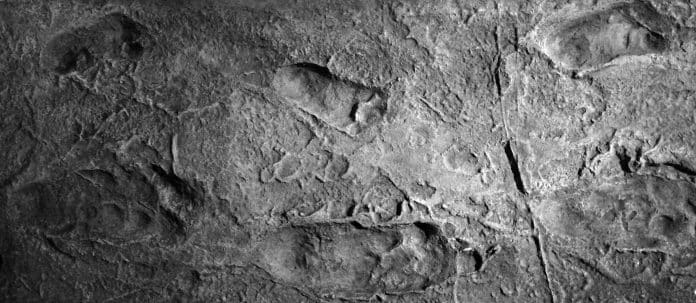What are Laetoli Footprints, Who Discovered Laetoli Footprints, Laetoli Pronunciation and More
Laetoli Footprints Definition and Location:
Where is Laetoli? Laetoli is a location in Tanzania that dates to the Plio-Pleistocene period and is renowned for its hominin footprints, conserved in volcanic dust. Site G, the spot of the Mary leakey Laetoli footprints. According to the laetoli tanzania map, it is located 45 kilometre south of Olduvai Gorge.
What is Laetoli footprints? Laetoli footprints are a series of footprints preserved in volcanic ash at the Laetoli site in Tanzania. The footprints are the oldest examples of early human walking. They provide insight into the locomotion of early humans and how they may have evolved into modern humans.
Who Discovered the Laetoli Footprints?
Mary Leakey and her team of archaeologists discovered the location,which can be seen on the Tanzanian laetoli map, and tracks in 1976. The Laetoli archaeological site was subsequently excavated in 1978. Upon analysis of the footprints, “The Laetoli Footprints” offered reliable proof for the bipedalism theory in Pliocene hominins and got significant recognition from scientists and the general public. Since 1998, paleontological exercises have continued under the headship of Terry Harrison of New York University and Amandus Kwekason of National Museum of Tanzania. This exercise has led to the repossession of more than 12 new hominin finds and extensive reconstruction of paleoecology.
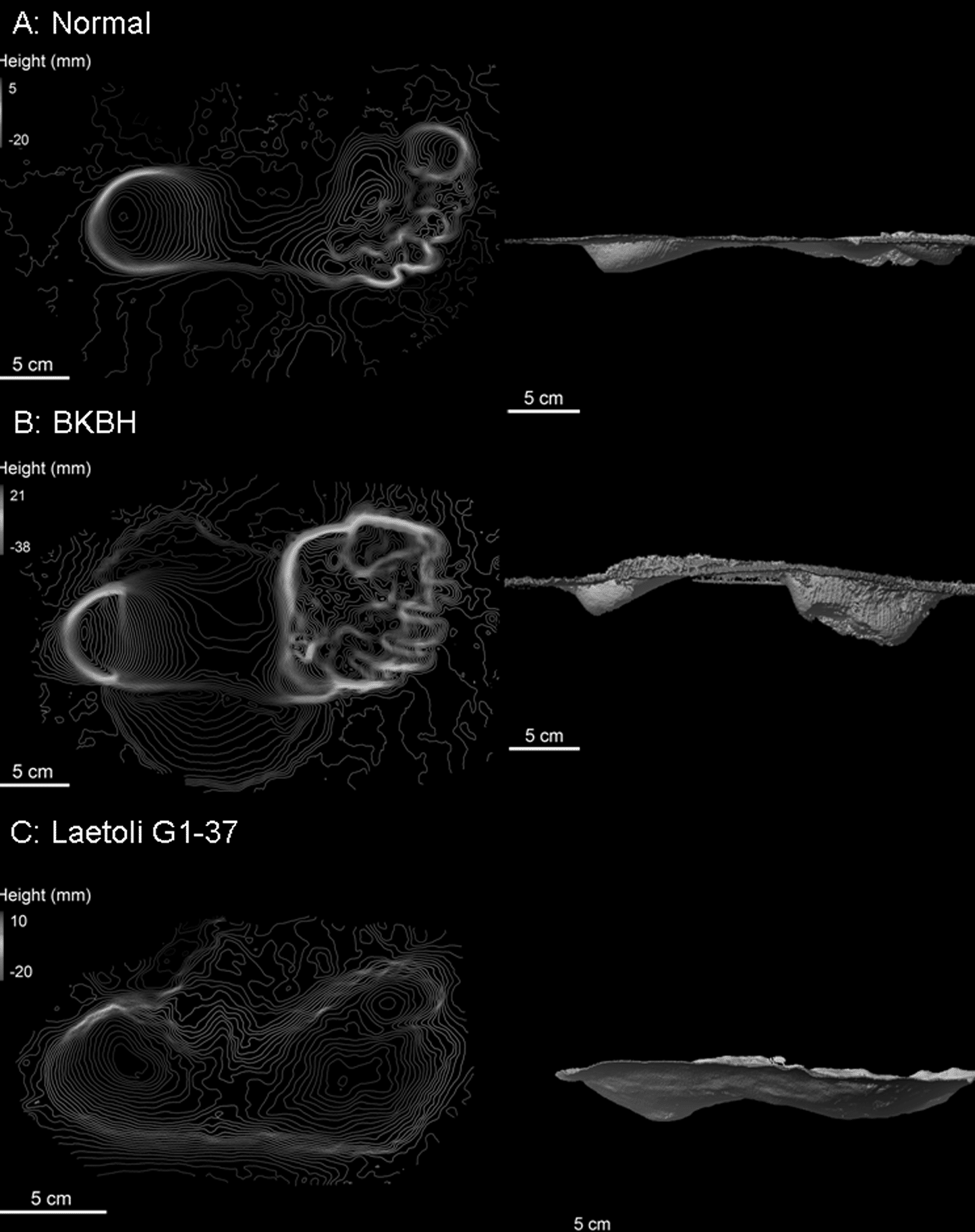
Which Species is Associated with the Laetoli Footprints
The footprints at laetoli in Tanzania date to about 3.7 million years old. They are the oldest known proof of bipedalism in hominins at the time. Older Ardipithecus ramidus fossils were later discovered with features that indicate bipedalism. Apart from the footprints laetoli, there were other things discovered at Laetoli in Tanzania, including animal and hominin skeletal remains. After analysing the skeletal structure and footprints, there was clear proof that bipedalism came before expanded brains in hominins. The identity of the hominin species who made the footprints of laetoli is hard to construe precisely. However, Australopithecus afarensis is most commonly suggested in editorial laetoli publications.
Background of Laetoli
Research History
Western science first recognized Laetoli Tanzania in 1935. A man called Sanimu persuaded archaeologist Louis Leakey to take a closer look at the area. Many fossilized mammalian remains were recovered with a left lower canine tooth initially thought to belong to a non-human primate. However, it was later revealed (by T. White and P. Andrews in 1979) as the site’s first fossilized hominin remains.
German archaeologist Ludwig Kohl-Larsen extensively investigated the site in 1939 and 1938. Many remains of hominins, including incisors, molars, and premolars, were identified. An excavation done later in 1959 did not reveal new hominins. Thus Laetoli footsteps in Tanzania became relatively uncharted till 1974 – when George Dove discovered a hominin premolar. This discovery sparked new interests in the laetoli site. Mary Leakey came back and unearthed the well-preserved remnants of hominins almost immediately. In 1978, Mary Leakey’s 1976 unearthing of hominin tracks –“The Laetoli Footprints”- offered convincing proof that Pliocene hominins were biped. The discovery got significant recognition from laymen and scientists.
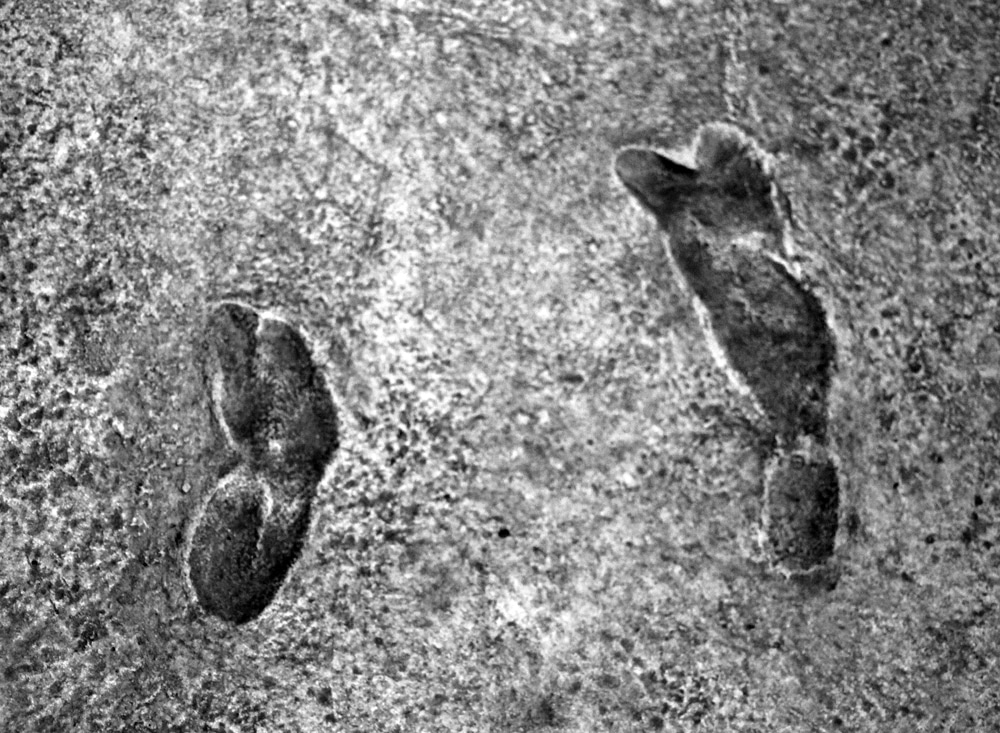
Possible Tracemaker
The Laetoli Footprints Reconstruction and Analysis:
Although a subject of widespread debate, researchers have temporarily concluded that the three hominin humans who produced the Laetoli footprints species are Australopithecus afarensis. They made this laetoli editorial conclusion based on proof obtained from the restoration of the foot skeleton of a female Laetoli Australopithecus afarensis by anthropologists Gen Suwa and Tim Douglas White of the University of California coupled with the footprint analysis done by Russel Tuttle of the University of Chicago. Tuttle contrasted humans with other bipedal animals like primates and bears, including foot form and gaits, taking the use of footwear into account. For gait, Tuttle analysed the stride length, step length, foot angle, and stride width and concluded that the Laetoli footprints show that Australopithecus afarensis was more human than an ape in terms of gait.
Australopithecus afarensis is an obligate biped hominin. The start of sexual dimorphism is traced to the A. afarensis as well as brain sizes like that of modern gorillas and chimpanzees. Investigation of the footprints at Laetoli showed the attributes of obligate bipedalism – lateral force transmission between the heel to the metatarsal base, evident heel strike from deep imprints, a deep imprint for the big toe corresponding with toe-off, a well-developed medial longitudinal arch, and adducted big toe.
Dating Techniques and Age
The two Laetoli footprints dating methods used to get the approximate age of the beds that constitute the ground Layers of Laetoli are stratigraphy analysis and potassium-argon dating. Based on these techniques, the layers were named thus, starting from top to bottom: Ngaloba Beds, Olpiro Beds, Naibadad Beds, Ogol lavas, Upper Ndolanya Beds, Lower Ndolanya Beds, Upper Laetoli Beds, and Lower Laetoli Beds. The ancient Laetoli Beds house the footprints laetoli trackway. The upper section of the Laetoli Beds dates back to 3.6 to 3.8 million years ago. The beds are mostly tuffs with a peak thickness of 130 m. No traces of mammalian fauna was discovered in the lower section of the Laetoli Beds, and no date could be ascribed to the layer.
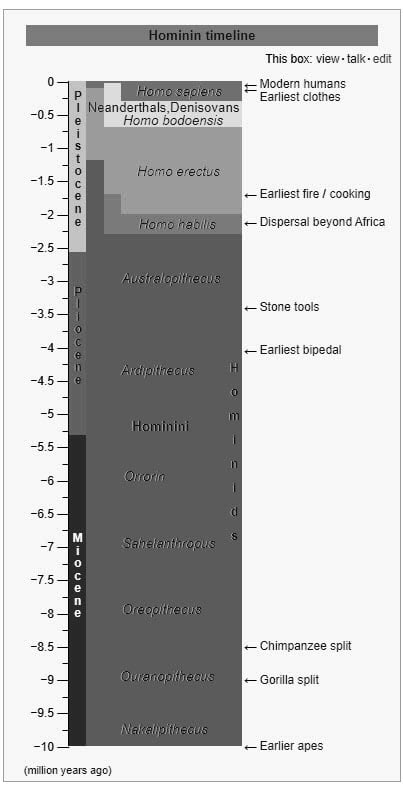
Located above the Laetoli Beds, the Ndolanya Beds can be clearly divided into lower and upper sections divided by a widespread calcrete deposit that is up to one metre thick. Like the Lower Laetoli Beds, the Ndolanya Beds cannot be dated. The Ogol lavas are 2.4 million years old. No artefacts or fauna were recovered from the Naibadad Beds. However, based on mineral composition, they are associated with a bed layer at Oldupai Gorge. Acheulean artefacts and Pleistocene fauna have been discovered in the Olpiro Beds. Based on a trachytic tuff that happens within the beds. Therefore, the Ngaloba Beds could be dated between 12,000 to 150,000 years BP.
Laetoli Discoveries
Hominin Footprints from Site G
The most important discovery that Mary Leakey and her team made in 1976 was a 24-metre (75-foot) line of hominin fossil Laetoli foot prints. The footprints were only fully excavated in 1978. They were preserved in powdery volcanic ash initially believed to have emanated from an eruption of the Sadiman volcano nearby. However, more recent studies of the Sadiman volcano have revealed that it is not the origin of the Footprint Tuff at Laetoli. Soft rain sealed the ash layer (150 mm thick) to tuff without damaging the prints. Other ash deposits covered them as time went by.
Yale’s Andre Hill discovered the fossil footprints whimsically when he visited Mary Leakey laetoli site in 1976. Hill was trekking back to camp one evening and fell while trying to evade a large chunk of elephant droppings a colleague threw at him. With his face only a few inches away from the surface of the rock, he recognized the footprints at laetoli were made by rhinos and antelopes preserved in the volcanic ash, among which he found hominid footprints.
Three individuals made the hominin prints. One walked in the footprints of the other, which made it hard to recover the first afarensis footprints. Since the tracks lead in the same direction, a group of people going to a waterhole together likely made them. However, there is little or no proof to back the widespread assumption that a nuclear family made the prints.
| 1st hominin | 2nd hominin | |
| Footprint width | 10 centimetre | 8.8 centimetre |
| Footprint length | 21.5 centimetre | 18.5 centimetre |
| Length of stride | 47.2 centimetre | 28.7 centimetre |
| Reconstructed body size | 1.34 to 1.56 metre | 1.15 to 1.34 metre |
The Laetoli footprint show that the hominins walked upright habitually as no knuckle impressions were found. The feet didn’t have the mobile big toes of apes; rather, they had an arch (bent sole) like modern humans. The hominins seemed to have walked in a casual stroll.
Based on information from Australopithecus laetoli afarensis skeletal remains and the footprint spacing, computer simulations show that the hominins walked at 1.0m/s or higher – a rate that matches the walking speeds of humans. Results from other researches have also backed the theory of a human-like gait.
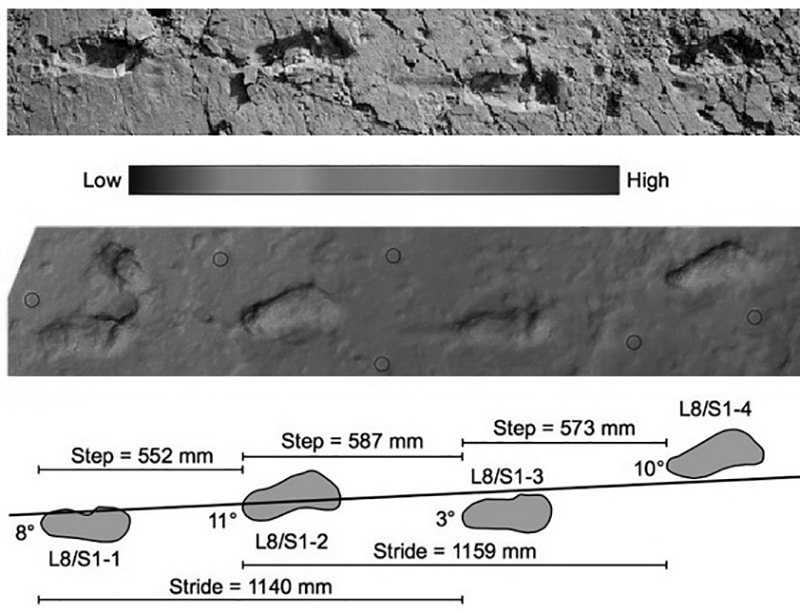
Hominin Prints from Site S
In 2015, a new set of footprints almost the same as the laetoli footprints age as the first reported ones were discovered at a place approximately 150 m south of the initial site G footprints. This place is referred to as site S. The two persons who produced the footprints are named S2 and S1. S2 has only 1 print, while S1 left a track of footprints. Further analysis showed that S1 was much bigger than any of the three persons from Site G.
Other Footprints and Artefacts
Other footprints indicate the existence of 20 different species of animals apart from the hominin Australopithecus afarensis, including baboons, hyenas, gazelles, wild cats, giraffes, wild boars, birds, hares, elephant relatives (belonging to the now extinct genus Deinotherium), and different types of antelopes. Rain prints can also be seen. Some footprints overlapped, which means they were covered up rapidly. Many of the animals are represented by skeletal remnants found in the vicinity.
No artefacts have been unearthed in the area, at least within the ancient Laetoli Beds that house the trackway. However, artefacts from younger beds like Ngaloba and Olpiro Beds, also preserved at Laetoli, have been discovered.
Significance and Interpretation
Before the Laetoli footprints were discovered, there was a lot of debate as regards which came first in the evolutionary timeline of humans: bipedalism or a bigger brain. The unearthing of the footprints settled the debate. It proved that Laetoli hominins fully walked on two feet long before the modern human brain evolved, and they walked on two feet almost one million years before the production of the earliest known stone tools. The footprints are believed to possibly belong to A afarensis.
In some analysts’ interpretations, they noted that the shorter laetoli footprint trails carries “unmistakable signs that imply that whoever made the footprints was weighed down on one side.” This may be an indication that a woman was carrying a child on her hip. However, this cannot be ascertained.
The footprints were an improbable finding due to the fact that they closely look like the footprints of modern humans, despite being 4 million years old. Also, it is noted that the toe pattern is the same as the human foot, which is very distinct from the feet of other non-bipedal creatures and chimpanzees. The footprints have been described as being the same as the stride of modern humans – the heel strikes first, weight transfers to the ball of the foot and the toes are pushed off.
The stratigraphic analysis also provides an understanding of the climatic conditions at the time the footprints were made. Pliocene sediments indicate that the environment was more humid and productive than the present. Changes in climate that led to a shift from forest to grassland environments strongly correlate with bipedalism and upright posture in hominins. This perhaps started the bipedal evolution of the hominins discovered at Laetoli Africa.
Footprints in Stone at Laetoli Tanzania
Where were the laetoli footprints found? The Laetoli footprints Lucy and Laetoli were discovered in Tanzania. Laetoli was discovered in 1978 by paleoanthropologist Mary Leakey and her team. They were found in Laetoli, Tanzania, and are believed to be the footprints of two hominin individuals who lived around 3.6 million years ago. The footprints are preserved in volcanic ash and are some of the oldest human footprints ever found.
What Were Lucy and Laetoli What Species?
What were lucy and laetoli: Lucy and Laetoli were two early hominin fossils found in Africa. Lucy was an Australopithecus afarensis, which lived about 3.2 million years ago, and Laetoli was an Australopithecus afarensis, which lived about 3.6 million years ago. Both species are thought to be ancestors of the Homo genus, which includes modern humans.
Conservation and Preservation
Having been recorded, the Laetoli prints were reburied in 1979. This was a then-new method of preservation. Acacia trees re-vegetated the site. Giving rise to fears of root growth. A GCI-Tanzanian team investigated this in 1992. They opened a 3-by-3 metre trench, which revealed that roots had ruined the footprints. Conversely, the part of the trackway untouched by root growth remained well-preserved. The success of this experiment gave rise to increased use of reburying for site preservation.
Laetoli footsteps were taken to stop erosion in 1993. The original pathway was reconstructed, and new casts were built. Since the pathway is quite fragile, the new cast was used to guide the re-excavation works done in the area. A group of specialists that included Fiona Marshall excavated half of the pathway again to document its condition, stabilize the surface, pluck dead roots and rebury them with artificial geotextile materials, which allow the surface of the trackway to breathe and protect it against root growth.
There have been proposals to lift the track and move it to a confined location. However, the cost outweighs the benefits – a huge amount of money and extensive research would be required, and there is the risk of damage or loss. Therefore, burial looks like the most efficient preservation method.
For more articles related to Tourist Attractions in Tanzania click here!

























